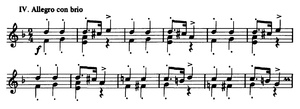4th symphony (Dvořák)
The Symphony no. 4 D minor op. 13 is a symphony of the Czech composer Antonin Dvorak .
Emergence
The symphony was written in 1874, a few years after the third symphony . At the time of the composition, Dvořák was able to celebrate a success with his hymn "The Heirs of the White Mountain", which also became famous in the USA and which a.o. a. Dvořák's later success there paved the way. From then on the symphonic works of the Bohemian composer were also noticed more strongly.
As in the 3rd symphony , Dvořák's preoccupation with Wagner's work can also be seen in this work , for example in the main theme of the second movement.
To the music
occupation
2 flutes , 2 oboes , 2 clarinets , 2 bassoons , 4 horns , 2 trumpets , 3 trombones , kettledrum , bass drum , triangle , cymbals , harp and strings
1st movement: Allegro
The main movement begins with a build-up of tension in the lower strings, which leads to a forward- pressing theme that is consistently performed forte and is first introduced in the winds. The second theme has a waltz-like character and is introduced by the cello. In the repetition, the three-quarter rhythm weighs in the bass while the theme is presented radiantly. The short implementation deals with both topics. For example, the waltz theme is effectively moved to a minor key. In some places the recapitulation has changed significantly compared to the exposition . This has not been unusual for symphonies from the Romantic era since Ludwig van Beethoven . A modification of the first theme leads to the end of the movement in throbbing D minor.
2nd movement: Andante sostenuto e molto cantabile
The second movement represents a set of variations for the first time in Dvořák's symphonic oeuvre. The theme, which is only presented by the brass, is reminiscent of Richard Wagner's Tannhäuser . The first variation brings the processing in the strings with a side thought performed by the cello and played around by the other strings. The second variation brings the woodwinds into play, accompanying the theme rhythmically shifted. It ends with a new side thought which, after a short tutti, leads to the third variation. This accelerates the topic and processes it with contrapuntal approaches. The fourth variation changes the rhythm and slows the action progressively in order to take up the side idea of the second variation again. There is no longer a variation in the actual sense of the word, but a few closing turns that give the sentence a peaceful ending.
3rd movement: Scherzo, Allegro feroce
The third movement is a typical Dvořák scherzo with folk and song-like themes. The Scherzo part begins with a tutti stroke of the whole orchestra, from which the melody, which is reminiscent of a Bohemian song, develops. Accompanied by kettledrum and drum, it paves its way. This time the trio does not form a pastoral contrast to the Scherzo theme, but puts the listener in the middle of a Bohemian folk festival, where a simple and catchy melody is thrown by the orchestra and accompanied by triangle, drum and kettledrum. The repetition of the scherzo concludes this popular third movement.
4th movement: Finale, Allegro con brio
There are two related topics in the last sentence. The first begins suddenly and hammering in the lower strings and is performed by the strings. In the repetition it appears played by the whole orchestra. The subsequent second theme is of a lyrical character and is introduced by the high strings. The hammering motif from the first theme continues to throb in the bass line. After processing both topics, the action moves down a semitone and takes up both topics again in a different way. The musical material is processed and changed until the end of the movement. A brilliant presentation of the lyrical second theme finally leads to the stormy and jubilant end of the symphony.
effect
On March 29, 1874, the third movement of the symphony was first performed as part of the world premiere of Dvořák's Third Symphony in Prague. The entire fourth symphony was then performed for the first time on May 25, 1874 in Prague under the direction of Bedřich Smetana . The work was immediately celebrated and considered a masterpiece of Dvořák. This symphony was also revised by the composer around 1887 and revised to a considerable extent.
The 4th symphony is now an important point on the path of the symphonic composer Dvořák. With the new symphony, he managed to confidently combine his personal style with the form of the symphony. The fifth symphony that follows continues this style with even greater maturity.
supporting documents
- Gottfried Eberle in: Lexicon Orchestermusik Romantik , ed. von Wulf Konold, Munich: Piper 1989, Vol. 1, pp. 192-195
- Christoph Hahn, Siegmar Hohl (eds.), Bertelsmann Konzertführer , Bertelsmann Lexikon Verlag, Gütersloh / Munich 1993, ISBN 3-570-10519-9
- Harenberg concert guide , Harenberg Kommunikation, Dortmund, 1998, ISBN 3-611-00535-5
Web links
- 4th Symphony (Dvořák) : Sheet music and audio files in the International Music Score Library Project




